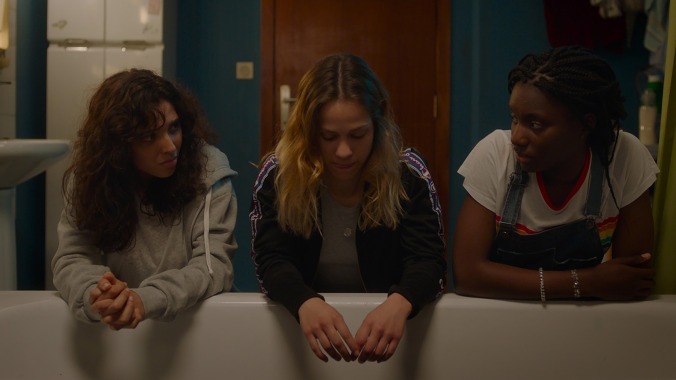The directors of Inside put their spin on Candyman in the folkloric slasher Kandisha
French directing team Alexandre Bustillo and Julien Maury combine Moroccan legend with ’90s horror style
Film Reviews Inside
Like Candyman, the new French horror movie Kandisha is set in a neglected housing project where kids play amid concrete rubble and torn-up old furniture. Like Candyman, it’s a supernatural slasher about a historical victim-turned-vengeful demon who’s unleashed by saying its name five times. Unlike Candyman, however, the villainous, yet strangely alluring title character of Kandisha only kills men. Six of them, to be specific, before she retreats back into the impulsively drawn blood pentagram from which she was summoned. And she’ll make quite a mess in the process.
That’s because Kandisha was written and directed by the creative team of Alexandre Bustillo and Julien Maury, whose 2007 debut Inside unsettled even jaded horror fans with its graphic, unblinking violence. Since then, the duo has struggled to live up to their early promise, experimenting with twisted fairytales, sadistic slasher flicks, and an ill-advised foray into franchise horror with the disappointing Leatherface in 2017. If you squint your eyes and include the Candyman parallels, Kandisha has all of these elements: It’s a teen-centric slasher movie overlaid with a fascinating real-life folktale that unofficially recalls a horror classic. And while it doesn’t quite pull Bustillo and Maury out of their slump, it has their fingerprints all over it.
The legend of Aicha Kandisha (or Kandicha, or Quandicha, depending on how you transliterate it) comes from Morocco, where she serves a cultural purpose rather like that of La Llorona in Central America. Associated with water and with female rage, she’s a bogeyman who keeps children away from dangerous areas, as well as a folkloric reminder of the atrocities of the country’s colonial past. According to the lore cited in the movie—which the characters freely admit comes from the internet—Aicha Kandisha was a striking, seductive Moroccan noblewoman who resisted Portuguese occupation by luring in colonizers with her feminine wiles, then slaughtering them. Centuries later, she’s become more indiscriminate, picking off any man in the orbit of multi-ethnic teenage graffiti crew Bintou (Suzy Bemba), Morjana (Samarcande Saadi), and Amélie (Mathilde Lamusse) after Amélie calls the demon in a moment of righteous anger—whether they deserve it or not.
Kandisha can be a shockingly cruel film: Even though it’s obviously fake, a scene of animal death is unblinking and prolonged, and the most direct solution to the metaphysical problem that dogs Amélie is almost comical in its coldness. The gore is clearly held back by budget—CGI blood makes several appearances, particularly in the first half—but the practical effects, when they do appear, are gruesome. Kandisha herself is a marvel of creature design, evolving over the course of the film from an eerie woman in a black burqa to a 7-foot-tall, faunlike monster with cloven hooves, a belly dancer’s body, and a veiled face. Combined with the cultural specificity of her lore, she makes for a fascinating antagonist.
The issue is, this evocative villain and vicious point of view are placed in a generic teen-horror context. Lots of horror movies do this—take a unique monster, and layer it over underdeveloped adolescent characters. But it doesn’t get any more interesting with repetition. Other issues with the film are also typical of low-budget horror: The acting is unconvincing, the plot predictable, the twists visible from miles away. The stock character of a disgraced exorcist even makes an appearance—he’s an ex-imam, not a former Catholic priest, but other than that, he’s a figure we’ve seen before. With all this in mind, the question is whether Kandisha’s intriguing elements are strong enough to cancel out its more uninspired ones. For Bustillo and Maury completists and seasoned fans of monster movies and ’90s horror who are accustomed to cherry-picking cool elements from forgettable films, the answer is yes. For the rest of the viewing public, summoning this demon probably isn’t worth the pain.
5 Comments
i just wanted to say that by italicizing 3 separate movie titles in the review name i had no idea what this was a review of.
You have to read the rest of the words too, in order. If you do that you will find the answer at the very end!
Even though it’s obviously fake, a scene of animal death is unblinking
and prolonged, and the most direct solution to the metaphysical problem
that dogs Amélie is almost comical in its coldnessThis sequel seems rather darker than the original.
I don’t know, look at those cold, unfeeling eyes……
Bustillo and Maury are uneven, but Leatherface was an interesting attempt in trying to do something else with the formula, and their 2011 movie Lurid is very diverting. https://www.imdb.com/title/tt1727516/?ref_=nm_flmg_wr_6Inside is one solely for the hard-bitten horror fans though…